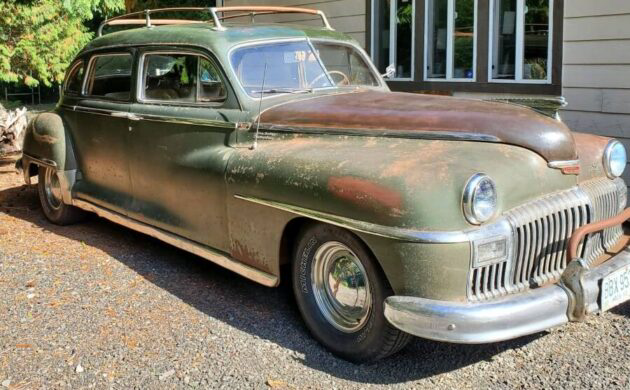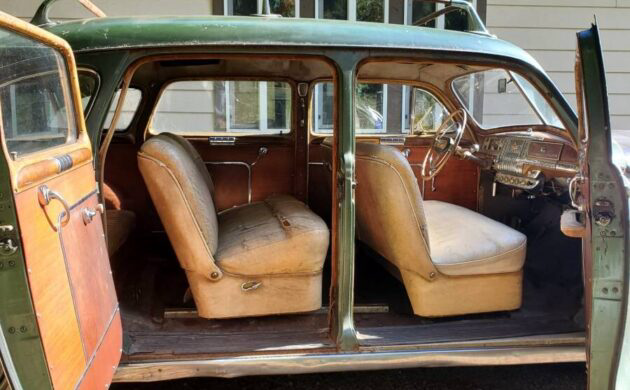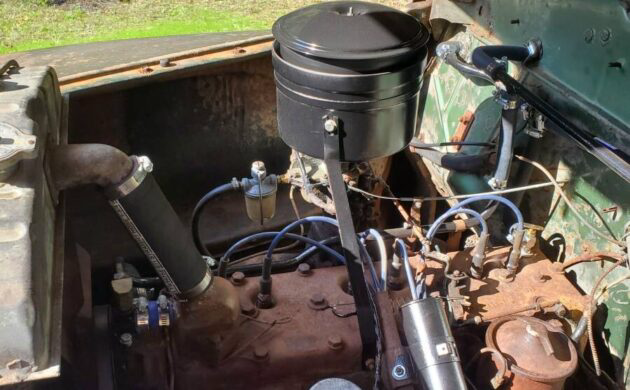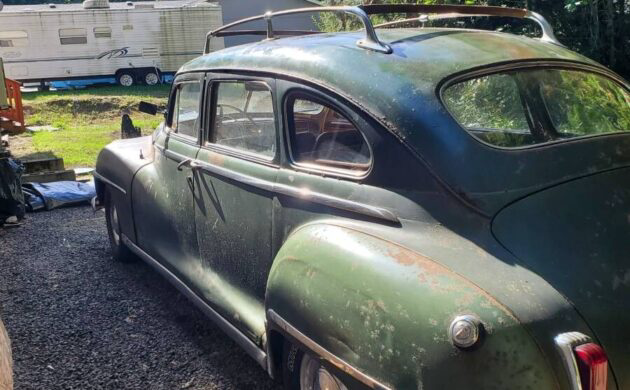OK, a show of hands if you have ever encountered a DeSoto Suburban such as this 1948 example. Full disclosure, we covered this vehicle in September of 2018. As the current seller states, he purchased it in 2019 and now wants to move it to a new home. So, what’s changed and what hasn’t since 2018? Let’s take a look and find out. Located in Lakebay, Washington, this very stretched sedan is available, here on craigslist for $6,500.
Here’s some quick backstory, the Suburban was offered between 1946 and 1954 though the “Suburban” name was dropped after the ’49 model year – a problem with Chevrolet/GM? Maybe, but anyway, these are long cars with a 139.5″ wheelbase and reverse-opening rear doors (I strongly dislike the term “suicide”). They employed jump seats with room for eight and were often delivered with a roof rack such as adorns our subject car. Total 1948 production reached 7,500 units.
Prior to the seller’s acquisition of this unusual car, it sat in storage since 1971. In the four years that he has owned this Suburban, he has installed new brakes, a new fuel tank, and replaced the coolant and heater hoses. The engine in question is a 109 HP, 236 CI, in-line six-cylinder powerplant that is said to “Starts and runs ok, has a miss“. Backing up the flathead is a Fluid Drive transmission that is described as, “shifts ok, except 1st to 2nd has a hard clunk“.
The exterior doesn’t look much different today than it did five years ago. There’s a lot of faded paint and surface rust though the body still shows as sound – in particular, that prominent DeSoto grille which doesn’t appear to have been kissed. The stainless trim is still attached though some of it looks s bit dented. I don’t see any sign of rot, but I would suggest a thorough inspection be conducted by any interested acquirers. It’s good to see that the original roof rack, a Suburban staple, is still planted right where it’s supposed to be.
The interior reveals an interesting configuration with the jump seats located behind the rear seat. The upholstery, overall, is fair at best and really could use some attention. The way back is finished in wood with stainless strips – typical materials used in this era. It appears to be original and is in pretty decent shape considering this car’s three-quarters of a century of existence. As for the dash, it has a lot of the typical chrome plated styling ques that are so reminiscent of the ’40s – particularly the very obvious, center-mounted radio speaker. While primitive by today’s standards, it is representative of what many consider to be the domestic automobile’s golden years – the post-war era.
Well, not much has changed in five years – mostly the price as the ask in 2018 was $4,500. The lack of progress begs the question why? I guess it depends on what an acquirer’s intentions really are – make it driveable, or restore it, or hot-rod it, or restomod it, etc. Regardless, I would suggest that this DeSoto Suburban needs to go to a new home, it’s an unusual model from a long-gone fallen-flag manufacturer and that’s reason enough to preserve it in some matter, wouldn’t you agree?







Calling Howard Cunningham…your car is waiting…
Exactly the Desoto used on the happy days show was owned by a man in Brookfield mass in the 80,s I got the chance to sit in it boy is that car big don’t know if it’s still around these parts though.
I remember seeing one before 1957, exactly when I’m not sure. It was dressed as a white ambulance, with the lights and siren as well as the roof rack. This was near Yakima, WA.
This ages me, I know!
Maybe you should call them rear hinged doors.
DeSoto had a lot of the cab market in NYC at one time. I think back then the law was a taxi had to seat at least 5 passengers behind the driver. This and the Checker were 2 of the very few that could be used. Cab drivers liked the Fluid Drive, they didn’t have to keep their foot on the clutch in traffic. It would be really neat if someone restored this to a period correct taxi cab. That would be a lot of fun and that is what this hobby is supposed to be about.
I fully agree. Thanks.
that dash is spectacular. Would look fantastic restored or maybe let Jonathan Ward at Icon to do a derelict build.
I know my dad a owned a De Soto when I was very young. Don’t recall the year or model, unfortunately.
My dad upon coming home from WWII purchased a 1946 Nash, then a 1950 Hudson, then a 1952 Buick Special, 1953 Buick Super, 1956 Buick Super, two tone pick&blue,(only one made this color combo). I was then finishing high school and going to college and purchased a used 1957 Plymouth Plaza for myself. Lost my parents when they were in their earily 60’s
It was used as a taxi just after the war in Belgium.
clunk is normal for a fluid drive
I had a 1951 Chrysler Imperial with fluid drive.and I would let up on the gas peddle then the “clunk” then put my foot back down on the gas. I sure liked having that V8 Hemi engine. I am fearful of this heavy car and only a flathead 6 engine.
Can the hp be upped with age appropriate modifications? Seems underpowered to me. This thing is huge. Would be show stopping fully restored.
You have to love this Desoto. An amazing land yacht and most worthy of the cost of getting it in a condition that would support operation on the road. The new owner would have to be able to chip away, over a multi year period of time to attack a: repaint, reupholstery, suspension rebuild, electrical system upgrade. In summary get it on the road so it is safe then prioritize what needs to be done and most of all take your time doing it. Parts are tough to find but life is a challenge.
Put a 5.7 hemi in it!
I’ve got one of these. Geezerglide is right, the genesis of it was for New York Taxis. Checker and Packard had a version that the cab companies liked, and the DeSoto was Chrysler’s entry. Sold a bunch of ’em for about 3 years. But the Suburban is another kind of fish. The marketing people decided there might be a market for a snazzier version for resorts like the Greenbrier and Pocono lodges to pick up their rich clientele at the train station and take them to the resort. The only upholstery in the car was leather on all the seats. Everything else was a wood grained plastic kinda like formica. The second row seat was part-number-identical to the front seat…had tracks that were 11 inches long so the 2nd row seat could slide forward to touch the front seat. The third row seats folded and there was no partition between the trunk (which was wood grained like the rest) so with the trunk open you almost had a station wagon. Rich folks traveled with lots of luggage, so the luggage rack was mandatory if the 3rd row seats were used. 5700lb car with about 85hp, not a drag racer! They only made a coupe hundred of the fancy ones. Don’t make a taxi out of it!
I forgot about the long wheelbase Packards. I think they even used the pre-war six in them and also used it in export cars too. There are some good old videos on youtube of late 40’s early 50’s NYC.
As a fan of film noir and all the Forties movies you can see on YouTube for free ( hint..hint), I often see these De Soto, could be Chryslers, with the Skyview sunroofs, used as taxis in the films. I don’t know if they were Suburbans per se. Hard to tell.
I’ve told the story before but…well…I repeat myself. Back in Colorado in 1972 I had a ’47 that I parked in front of the cabin I was living in just outside of Breckenridge , back before it became what it is today. One day I come out to get in the car to go to my job banging nails in freezing weather and the car was gone. Turns out the Summit County powers- that- be decided it was abandoned and as it straddled the public right of way, towed it and turned it into a cube of real American produced metal.
Being just a kid and not knowing what lever to push, I walked to work :)
Interested. Please call Mike 520-977-1110
Growing up in the 40s-50s, I recall a good friend who’s family had a ’35 Airflow, then a ’37 Airflow. Finally, by the mid-50s they upgraded to a postwar car – a ’48 DeSoto Suburban just like this one except a sort-of metallic gold/brown. IIRC, the door cards were all wood, and the seats were leather.
His only new car before 1956, my dad bought a ’39 Dodge that I only barely remember. With World War II came gas and tire rationing. Dad chose to sell it and we went through the remaining war years without a car. About 1946, he bought a ’36 DeSoto “Airstream” – DeSoto’s alternative body style – resembling the Plymouths and Dodges of the time. I remember it was a nice looking car but it smoked a lot, and Dad traded it for a ’37 DeSoto – also an “Airstream”. In our wider family there were seemingly tons of flathead Mopars – mostly sixes. They varied a lot in displacement but they all looked the same, sounded the same, and all seemed to offer the same anemic, although pleasant performance. Given the roads, brakes, tires, and speed limits we had in those years, the old flatheads certainly fared well as adequate, unexciting family cars. Yeah, that big old Suburban was a lot to lug around with a flathead six – but hey if it could get up to 55 in about 20 seconds and then stay there for the 25-35 miles of “open road” between towns, nobody – except the restless teenagers of my generation – was complaining. Different times, those…
And what did those restless teenagers drive? Well, my first car was a ’37 Plymouth. I was 16 and already indoctrinated by my aunt’s ’55 Dodge tri-color two-door hardtop – first year of the Dodge V8. Of course the Ply was way too slow for me, but at seventy dollars it was all mine and you can bet I loved it.
Dodge’s first V8 was in 53 on the Coronets. The sixes were Meadowbrooks. Same in 54 with the Royal as the top dog.
C Dickinson – I concede – you are correct. Now that you mention it, I do recall ’54 Dodges with the V8 logo above the grill, I recall ’53 DeSoto V8s, and ’52 (if not ’51) Chrysler V8s. It was Plymouth that did not get the V8 until ’55. For all four marques, the major revolution in ’55 was the breath of fresh air brought in by Virgil Exxner. These were beautifully balanced cars. Then they went and spoiled everything with the “tacked-on” fins in ’56. Oh, but 1957! Wow!!! To me the epitome of Exxner designs would be a ’57 Dodge two-door hardtop in red and white. As for the remainder of the Exxner years, how do you improve on aesthetic perfection? Artistically, there was nothing left to do with the fin concept. The changes in ’58 and ’59 served no other purpose than identifying the model years. They were newer, and that’s all. At best, they did not detract. For the most part, they only detracted.
No, I don’t mean that the tail fin era was the the pinnacle of automotive styling. In fact it may have been the pinnacle of nonfunctional excesses. But if there can be an ultimate aesthetic achievement in finned designs, I submit they achieved it in 1957. It was all downhill after that.
Just as the industry had to recover from tail fins, it had to recover from wrap-around windshields. For example, there were vestigial remains of the wrap-arounds in GM cars of ’62. Complete abandonment in 1963 opened the door to a new more functional aesthetics . To me, the pinnacle of the decade came with the ’65 Corvair.
And I have strayed far from ’48 DeSotos and replacing those flathead sixes with V8s. I have a final observation about all the early postwar offerings from American manufacturers. Most of these designs were warmed over 1940-41 designs, but the aesthetic goals seem to have been eliminating the external running boards and blending the front fender lines back at least into the front doors – if not further back.
Corporate Chrysler offerings in 1940-41 seem so remarkably lean and clean to me now. The length of the front fenders was just right. The running boards – now narrower were elegant and clean – an essential highlight of the design. By postwar years, what were once design highlights were now to be disguised – the design equivalent of an apology. “Sorry about these, folks, but we’ll hide ‘em as well as possible.” So we either had those funny bulges at the bottoms of the doors or we got the inverted-bathtub Packards of ’47-48 with acres of sheet-metal blending front and rear fenders into a single, bulbous unity. Chrysler designers weathered this “awkward stage” remarkably well. ’47-48 designs look sumptuous and comfortable rather than bulbous. Across the board, the design revolution of 1949 put these old problems to bed. Once again, we had fresh and clean designs. Of course Studebaker brought out their clean slate in 1946 and Raymond Loewy filled it with revolutionary ideas, leap-frogging over that awkward stage altogether.
Enough…
This jewel might have a burnt valve causing the miss , no fun to do a valve job on these flat head motors ! My father had a 52 Desoto with one of the first Hemi engines with fluid drive ! he thought he was on a race track every time he drove it ! LoL
I thought a valve job on any Chrysler six was an easy job. Simple to do, and sitting under the fender adjusting the tappets went quickly if I kept my hands off the exhaust.
I was about 15 or 16 when my brother bought a 48 desoto sedan. Just the two seats. The car was “Super” nice. Rode like a cloud. Never thought about being “Fast” in those days, it was a heavy car. But it would run 80 or more all day long. Upholsery on this one was not leather, but very “Sleepable” on long drives. One of the neatest things was the lighting in the speedometer. Below 50 it shown green, into the 50’s it went to yellow, and higher up it turned red, I suppose to warn you of your speed. Great, Smooth car. Leon
Our ’53 Chrysler New Yorker had dark blue wool upholstery that looked like new until it reached its demise in 1969. My sister backed it into a power pole in reverse at high speed. The body warped, but we drove it three more years, choking on exhaust fumes.
Right on, Leon! You’re bringing back a lot of fond memories. And how about those third center brake-lights Chrysler brought out in 1941. It took until 1986 – and a government mandate – to find these on ALL cars!
A lot of positive feedback and pleasant memories from the responders. Now I’m going to pee in someone’s cereal, IMHO the post-war up through 1952 DeSoto’s were about the ugliest cars ever produced.
I wonder why the designers went in that direction. Packard had the pregnant whale thing going about that same time.
Packard came at the problem from the opposite direction. They were building a lot of limos already. They just had to put a durable interior in that body to take the abuse of a taxi. My 50 Packard Standard Sedan came from the factory with rubber floor covering which was originally designed for the Taxis.
I am one of many fans of the fat fender Chrysler products of ’42-’48.
But Robert, ALL cars had rubber floor coverings back in the 40s-50s. Some had “carpeting” on the rear seat floor. In our ’37 DeSoto, it was sort of a jute-like stuff, and there were rear passenger foot rests too, and a rope hanging across the back of the front seat in four-door cars. There was a shade for the rear window – on a spring-retractible roller at the bottom of the window. At the top, it hooked on a little clip that was part of the rear courtesy light bezel. The switch for that light was on the B pillar. And most cars had right-foot-operated starters – why – because they had yet to have Bendix drives for engaging the starter. your foot operated not just the switch, but the engagement mechanism as well. By post-war years, we had starter buttons on the dash. Then in 1949, Chrysler shocked the world with ignition-key starter switches.
And remember vacuum windshield wiper motors? They worked great except when you really needed them. As soon as you stepped on the gas, they stopped! The switch was in the middle of the dash at the top.
And if you can remember most of this stuff, you’re older than dirt. At least I am…
Glad someone said that before I did.
One of these was abandoned and towed off the Ohio Turnpike in the late 60’s. Some local rock bands wanted this to haul their equipment. Knowing the towing operator, it went for scrap. Thing was huge!
Easy…10 people can fit in this. 3 up front..4 in the 2nd row..3 in the 3rd row…given the everyone doesn’t weigh more than 170lbs lol! And are hight and weight proportionate.
Not dealing with an airplane here Rust! and, since the front seat and 2nd row seat are identical, why 3 in front and 4 in second row? Those 3rd row seats are pretty narrow as the pax compartment tapers to the rear…not sure you could fit 3 back there.
It’s amazing that a car with that long of a hood has such a shallow engine bay.
Look under the hood of an early fifties Cadillac. The V8 looks tiny in the back of that long compartment designed for a straight eight.
Mr. Pittman, Cadillac stopped with straight eight engines in the 30’s. I believe Cadillac wanted to allow for a very large crash zone under the hood.
Take a look at a Lincoln Mark III from the side and see where 50% of the length of the car is in front of the windshield. You need good eyesight just to see beyond the hood.
Having a log hood allows the automobile buyer to entertain that this is a more powerful and faster automobile. I am sure marketing was pushing the designers to longer hoods and designs that imply the car is fast.
I remember most American cars of the ‘50s and ‘60s had room for another engine in front of the radiator. I think long hoods were part of the aesthetic even as far back as the 1920s. But for it to start showing, first we had to get used to the idea of the grill and radiator being separate and apart – way apart. Then we had to get through the Great Depression wherein extravagances were unjustfiable for most buyers. Then came WW II and no cars at all for a few years. Think about it: the pent-up demand of the post-war years finally made extravagance marketable.
During the Korean war there was a shortage of nickel for commercial use and 1951 through 1853 automobiles had chrome of a lower quality. This element prevents oxidation of carbon steel. I had a hard time keeping the chrome looking good on a mint 1953 Lincoln for many years.
This is beyond a boat……
Supertanker all the way….
Love it….